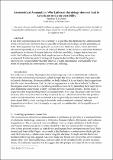Files in this item
Asymmetrical assumption : why Lutheran christology does not lead to kenoticism or divine passibility
Item metadata
| dc.contributor.author | Holmes, Stephen R. | |
| dc.date.accessioned | 2019-11-14T10:30:09Z | |
| dc.date.available | 2019-11-14T10:30:09Z | |
| dc.date.issued | 2019-11-12 | |
| dc.identifier | 252060610 | |
| dc.identifier | e76e58a7-074c-4c50-8653-90bfe618fb9c | |
| dc.identifier | 85079769322 | |
| dc.identifier | 000510618800001 | |
| dc.identifier.citation | Holmes , S R 2019 , ' Asymmetrical assumption : why Lutheran christology does not lead to kenoticism or divine passibility ' , Scottish Journal of Theology , vol. 72 , no. 4 , pp. 357-374 . https://doi.org/10.1017/S0036930619000589 | en |
| dc.identifier.issn | 0036-9306 | |
| dc.identifier.other | ORCID: /0000-0003-4222-8209/work/64697676 | |
| dc.identifier.uri | https://hdl.handle.net/10023/18919 | |
| dc.description.abstract | It has been commonplace for over a century to argue that the distinctively Lutheran form of the communicatio idiomatum leads naturally to kenotic christology, divine passibility, or both. Although this argument has been generally accepted as a historical claim, has also been advanced repeatedly as a criticism of ‘classical theism’ and has featured significantly in almost all recent defences of divine passibility, I argue that it does not work: the Lutheran scholastics had ample resources drawn from nothing more than ecumenical trinitarian and christological dogma to defend their denial of the genus tapeinoticum. I argue further that this defence, if right, undermines a remarkably wide series of proposals in contemporary systematic theology. | |
| dc.format.extent | 490997 | |
| dc.language.iso | eng | |
| dc.relation.ispartof | Scottish Journal of Theology | en |
| dc.subject | Christology | en |
| dc.subject | Divine passibility | en |
| dc.subject | Kenosis | en |
| dc.subject | Lutheran theology | en |
| dc.subject | BT Doctrinal Theology | en |
| dc.subject | T-NDAS | en |
| dc.subject | BDC | en |
| dc.subject | R2C | en |
| dc.subject.lcc | BT | en |
| dc.title | Asymmetrical assumption : why Lutheran christology does not lead to kenoticism or divine passibility | en |
| dc.type | Journal article | en |
| dc.contributor.institution | University of St Andrews. School of Divinity | en |
| dc.identifier.doi | https://doi.org/10.1017/S0036930619000589 | |
| dc.description.status | Peer reviewed | en |
| dc.date.embargoedUntil | 2019-11-12 |
This item appears in the following Collection(s)
Items in the St Andrews Research Repository are protected by copyright, with all rights reserved, unless otherwise indicated.

